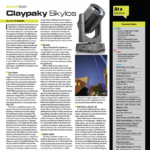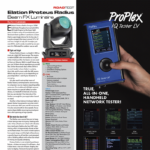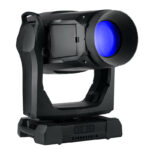In a world where every manufacturer is chasing the next great LED configured fixture or inventing their version of a hybrid luminaire, it is pretty exciting to see a light come out that isn’t competing with anything else in the market. Elation’s design team has once again raised the bar by unleashing their Sniper 2R. This award-winning fixture was released last year at the PLASA show in London, and its laser simulation capabilities and high speed scanning mirror system made it the talk of the show floor.
Three Fixtures in One
Billed as a 3-in-1 fixture — Beam, Scanner and Laser simulator, which is made through a system of 3 mirrors, the light beam emitted by the Sniper can move on an X/Y and Z-axis as well. The X and Y mirrors are used for panning and tilting the beam. It can move in a slow speed or quickly, in an almost-undetectable, lighting-fast movement. I hooked one of these fixtures up to my light console. The beam itself is a 3° pencil thin shaft of light. I was easily able to focus the small tight beam in one position on stage left. I then recorded another focus position on stage right. I put the two cues in a chase over one-second time and watched as the beam moved like a typical scanning mirror light. It was a little jumpy when moved slowly, as if they were on 8-bit motors. That was before I noticed the 16-bit option for smooth motors. I put the chase in a one-tenth-of-a-second time and watched with amazement as the light beam scanned across the entire stage five times in one second.
 I now notice that they have implemented the use of two different movement speeds on the fixture. You have “standard” and “high” speed scan rates. Standard give you a smoother sweeping beam of light more suitable for typical moving light pan and tilt, while the other mode gives the user a hyper fast scan rate. This is where the true laser emulation comes in. If the user is running the fixture in maximum channel (extended) mode, they can change this function at any time on the console. If not run in this mode the user has to choose the speed they prefer in the set up control panel. As if all these options weren’t enough, Elation offers up a feature I have yet to see on any other moving light. It offers a “shaking” pan and tilt feature. That’s right; the user can make the whole beam shake as it pans or tilts in direction. You can shake the pan while only tilting the light beam and it looks just wicked. Basically, it’s like an effect engine in a console built into the fixture profile, allowing you to chase between extreme pan/tilt at variable speeds.
I now notice that they have implemented the use of two different movement speeds on the fixture. You have “standard” and “high” speed scan rates. Standard give you a smoother sweeping beam of light more suitable for typical moving light pan and tilt, while the other mode gives the user a hyper fast scan rate. This is where the true laser emulation comes in. If the user is running the fixture in maximum channel (extended) mode, they can change this function at any time on the console. If not run in this mode the user has to choose the speed they prefer in the set up control panel. As if all these options weren’t enough, Elation offers up a feature I have yet to see on any other moving light. It offers a “shaking” pan and tilt feature. That’s right; the user can make the whole beam shake as it pans or tilts in direction. You can shake the pan while only tilting the light beam and it looks just wicked. Basically, it’s like an effect engine in a console built into the fixture profile, allowing you to chase between extreme pan/tilt at variable speeds.
 By doing this, the beam emulates a laser scanning. I’m going left to right with this great effect when I realize I have not even touched the Z-axis encoder. So while the fixture is scanning away, I grab the Z-axis, which is meant to change the overall plane of projection and move the effect around the room. I watch as I can relocate the beam on stage to wherever I wish. To start with, I just put the Z rotation in a circle effect and watch the single beam execute the form perfectly. I then add my scanning laser like effect to the mix. I have achieved EDM/Disco nirvana. This is like adding a whole new gizmo to any lighting designer’s toy box. But they are not done yet. They have a channel for pattern macros. I thought this would be for gobo effects but no — these are a whole bunch of pre-programmed directional movement chases for laser pattern effects. These mirrors are so fast that they can make the light beam simulate a cross or square shape among countless others. So in a true definition, these pattern macros are creating a gobo-like beam through fast scanning. Add to this the fact that you can rotate and zoom the size of these scanning gobos as well. I can swear I’m looking at low wattage lasers, but with an affordable price tag considerably lower than any real laser system (or any worry about retina damage.)
By doing this, the beam emulates a laser scanning. I’m going left to right with this great effect when I realize I have not even touched the Z-axis encoder. So while the fixture is scanning away, I grab the Z-axis, which is meant to change the overall plane of projection and move the effect around the room. I watch as I can relocate the beam on stage to wherever I wish. To start with, I just put the Z rotation in a circle effect and watch the single beam execute the form perfectly. I then add my scanning laser like effect to the mix. I have achieved EDM/Disco nirvana. This is like adding a whole new gizmo to any lighting designer’s toy box. But they are not done yet. They have a channel for pattern macros. I thought this would be for gobo effects but no — these are a whole bunch of pre-programmed directional movement chases for laser pattern effects. These mirrors are so fast that they can make the light beam simulate a cross or square shape among countless others. So in a true definition, these pattern macros are creating a gobo-like beam through fast scanning. Add to this the fact that you can rotate and zoom the size of these scanning gobos as well. I can swear I’m looking at low wattage lasers, but with an affordable price tag considerably lower than any real laser system (or any worry about retina damage.)
The light output from this 132W Philips Platinum 2R is plenty bright. Focused directly into the audience, the beam is not overly offensive, and when in high scanning mode (as I had just used the fixture) it is not bothersome to my eyes. I park the beam static and take out my light meter. From 15 feet’ away, I’m getting slightly more than 4000 foot-candles on my readings. From about 100 feet away, I’m measuring 2000 lux — bright enough to cut through a stage wash and see the effects. The bulb emits a pure white light measuring 8000K in color temperature, and I’m told that it has a life expectancy of 6,000 hours, which is pretty phenomenal for any discharge bulb.
Gobo and Color Options
I take a look at the gobos on the Sniper. It’s a stamped wheel with 18 choices. There are small hole gobos for beam reduction as well as multiple hole configurations, from two holes to a star field. I put the cone gobo in, and it reads like a thin cone. But then I turn on my quick scanning laser effect and I am blown away by how cool this looks. Imagine 20 of these fixtures in your face with laser-like cones. The gobo wheel can spin continuously in either direction at variable speeds for a gobo roll effect that resembles sparkling light beams. While the fixture itself has no zoom lens to widen the beam, there is a pattern zoom function that allows the programmer to make the pattern appear in different sizes. Like a small X shaped versus a large X shape. The function simply widens the scanning effect.
Besides the gobo, there is a 3-faceted prism that spreads the beam into three distinctive tight beams that, while symmetrical, are spread out wide. This is brilliant thinking, as the beam does not look like it has a typical 3-hole gobo in it. By adding a gobo to the prism the user does NOT get what every other light fixture offers, which is just a fatter beam. The Sniper now gives you three distinctive beams that have the same gobo in them. Of course the prism rotates as well. I start rotating it without the gobo and it resembles a propeller. I pop in a 4-hole gobo and this beam configuration is just killer, and I’m not even using the scanning mirrors!
Dimming wise, the dimmer is smooth enough. Various sync and random strobe rates are present. Color wise, we have a color wheel, no color mixing. Mixing dichroic color filters would diminish the light output, so I’m happy to deal with just the wheel. There are 14 colors plus open white on the wheel. All the colors of the rainbow are included, although there is no CTO choice. I would have preferred that to the pineapple yellow color they offer. Half colors work well. The manufacturers were smart enough to realize that putting the colors in the right order on the wheel is very smart. For instance, red is next to the open white slot, and green is next to blue. Designers like bumping between those color combos with no other color in between. The color order works well with the half color output as well.
Meat and potato wise, the fixture occupies a small footprint at 14 by 12 by 11 inches (LxWxH) with the yoke extended. PowerCON connectors feed AC to the 100-240 volt power supply, and 5-pin XLR connectors transfer DMX input/outputs. Optional wireless DMX transceivers and emitters are available. The Sniper may be able to punch like a heavyweight, but it weighs in at a mere 21 pounds. The Sniper would benefit any show.
At a Glance
A Triple-Duty Fixture
Elation’s Sniper 2R may not emit actual laser beams, but by pairing up laser simulation capabilities with a high speed scanning mirror system, this fixture succeeds in carving a unique niche as hybrid effects projector, scanner and laser simulator.
Pros: New unique fixture, laser like effects, built-in effects, high speed scanner
Cons: Could use a CTO color filter in the wheel
MSRP: $1,999.99
MAP: $1,499
More Info: www.elationlighting.com



